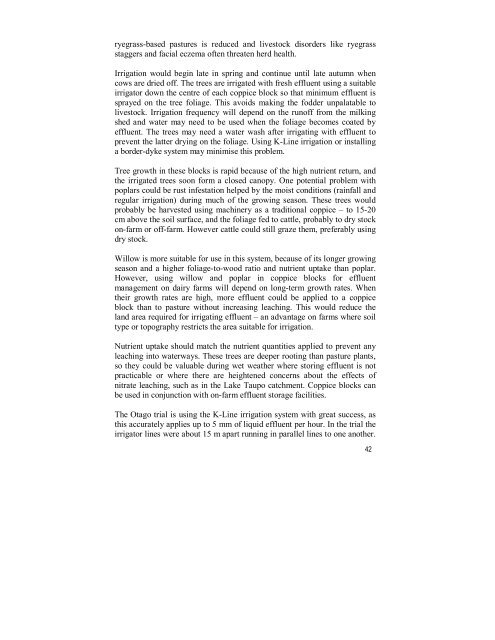Growing Poplar and Willow Trees on Farms, National - FAO
Growing Poplar and Willow Trees on Farms, National - FAO
Growing Poplar and Willow Trees on Farms, National - FAO
Create successful ePaper yourself
Turn your PDF publications into a flip-book with our unique Google optimized e-Paper software.
yegrass-based pastures is reduced <str<strong>on</strong>g>and</str<strong>on</strong>g> livestock disorders like ryegrass<br />
staggers <str<strong>on</strong>g>and</str<strong>on</strong>g> facial eczema often threaten herd health.<br />
Irrigati<strong>on</strong> would begin late in spring <str<strong>on</strong>g>and</str<strong>on</strong>g> c<strong>on</strong>tinue until late autumn when<br />
cows are dried off. The trees are irrigated with fresh effluent using a suitable<br />
irrigator down the centre of each coppice block so that minimum effluent is<br />
sprayed <strong>on</strong> the tree foliage. This avoids making the fodder unpalatable to<br />
livestock. Irrigati<strong>on</strong> frequency will depend <strong>on</strong> the runoff from the milking<br />
shed <str<strong>on</strong>g>and</str<strong>on</strong>g> water may need to be used when the foliage becomes coated by<br />
effluent. The trees may need a water wash after irrigating with effluent to<br />
prevent the latter drying <strong>on</strong> the foliage. Using K-Line irrigati<strong>on</strong> or installing<br />
a border-dyke system may minimise this problem.<br />
Tree growth in these blocks is rapid because of the high nutrient return, <str<strong>on</strong>g>and</str<strong>on</strong>g><br />
the irrigated trees so<strong>on</strong> form a closed canopy. One potential problem with<br />
poplars could be rust infestati<strong>on</strong> helped by the moist c<strong>on</strong>diti<strong>on</strong>s (rainfall <str<strong>on</strong>g>and</str<strong>on</strong>g><br />
regular irrigati<strong>on</strong>) during much of the growing seas<strong>on</strong>. These trees would<br />
probably be harvested using machinery as a traditi<strong>on</strong>al coppice – to 15-20<br />
cm above the soil surface, <str<strong>on</strong>g>and</str<strong>on</strong>g> the foliage fed to cattle, probably to dry stock<br />
<strong>on</strong>-farm or off-farm. However cattle could still graze them, preferably using<br />
dry stock.<br />
<str<strong>on</strong>g>Willow</str<strong>on</strong>g> is more suitable for use in this system, because of its l<strong>on</strong>ger growing<br />
seas<strong>on</strong> <str<strong>on</strong>g>and</str<strong>on</strong>g> a higher foliage-to-wood ratio <str<strong>on</strong>g>and</str<strong>on</strong>g> nutrient uptake than poplar.<br />
However, using willow <str<strong>on</strong>g>and</str<strong>on</strong>g> poplar in coppice blocks for effluent<br />
management <strong>on</strong> dairy farms will depend <strong>on</strong> l<strong>on</strong>g-term growth rates. When<br />
their growth rates are high, more effluent could be applied to a coppice<br />
block than to pasture without increasing leaching. This would reduce the<br />
l<str<strong>on</strong>g>and</str<strong>on</strong>g> area required for irrigating effluent – an advantage <strong>on</strong> farms where soil<br />
type or topography restricts the area suitable for irrigati<strong>on</strong>.<br />
Nutrient uptake should match the nutrient quantities applied to prevent any<br />
leaching into waterways. These trees are deeper rooting than pasture plants,<br />
so they could be valuable during wet weather where storing effluent is not<br />
practicable or where there are heightened c<strong>on</strong>cerns about the effects of<br />
nitrate leaching, such as in the Lake Taupo catchment. Coppice blocks can<br />
be used in c<strong>on</strong>juncti<strong>on</strong> with <strong>on</strong>-farm effluent storage facilities.<br />
The Otago trial is using the K-Line irrigati<strong>on</strong> system with great success, as<br />
this accurately applies up to 5 mm of liquid effluent per hour. In the trial the<br />
irrigator lines were about 15 m apart running in parallel lines to <strong>on</strong>e another.<br />
42

















